Complex results are supported in HyperView and can be animated using the Modal Animation Mode,  . After switching the animation mode to modal, an additional option appears in the Contour panel which allows the users to set the Complex filter.
. After switching the animation mode to modal, an additional option appears in the Contour panel which allows the users to set the Complex filter.

The Complex filter selections available are:
|
The response with varying angle or ωt (in degree).
|
|
Magnitude (r) of the complex result.
|
|
Phase  of the complex number. of the complex number.
|
|
Real part (x) of the complex number.
|
|
Imaginary part (y) of the complex number.
|
Results that are complex are shown in the Result type list with a (c) appended to the result name. The other selections in the Contour panel are the same for complex results, as they are for non-complex results.
To view the contour of the complex response at a certain angle, use the Animation Controls icon  . Within the Animation Controls panel, use the Current angle entry field to enter in the value for the angle.
. Within the Animation Controls panel, use the Current angle entry field to enter in the value for the angle.

Also in the Animation Controls panel, the Angular Increment can also be set. This is used when animating the model (see image above). To start the animation, click on the Start/Pause Animation button  .
.
Exercise
The following exercise is an example of how post-processing complex results in HyperView is done. The model used in this exercise has four load cases. The first load case contains the static result. The second load case resets the model to an unloaded structure and is the base state used for load case 3 where the eigenfrequencies are extracted. In load case 4, the response of the mass element (element ID 999) on top of the clip due to a dynamic excitation (frequency dependent load) of the bearing in a node (node id 10000) is analyzed. The model is fixed in all six degrees of freedom at node 9999.
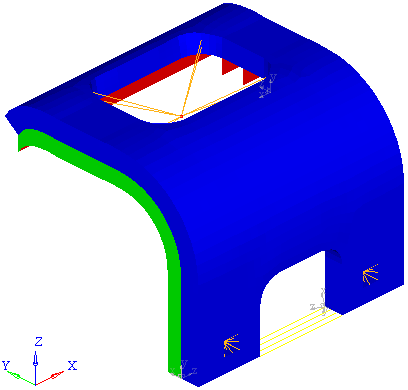
This exercise uses the model file Postprocessing_demo.inp and the corresponding results file Postprocessing_demo.odb.
Step 1: Import the model into HyperView and set the animation mode to modal.
| 1. | Click the arrow next to the Page Window Layout icon  on the Page Controls toolbar, and select the three window layout on the Page Controls toolbar, and select the three window layout  . . |
| 2. | Go to the Load Model panel by selecting File > Open > Model from the main menu. |
| 3. | Load the model file Postprocessing_demo.inp and the results file Postprocessing_demo.odb, located in the animation folder. |
| 4. | Verify that the window on the left is the active window (it will have a cyan box surrounding it). |
| 5. | Click Apply to bring the model and results into HyperView. |
| 6. | Click on the downward pointing arrow next to the Animation Mode Menu icon  and select and select  Set Modal Animation Mode. Set Modal Animation Mode. |
Step 2: Set the load case to load case 4 and contour the model.
| 1. | From the Results Browser, use the Change load case drop-down menu to set the load case to Step-4. |
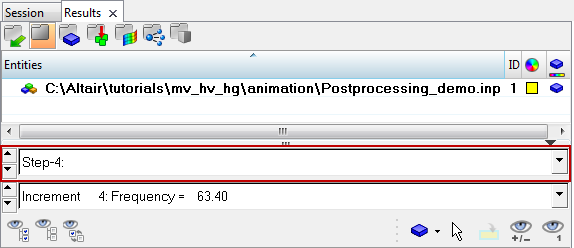
| Note | The Change load case toolbar visibility can be toggled on/off using the Configure Browser option (located in the Results Browser context menu). |
| 2. | Use the second drop-down menu to set the simulation to Increment 4: Frequency = 63.40. |
| 3. | Click the Contour panel button  on the Result toolbar to enter the Contour panel. on the Result toolbar to enter the Contour panel. |
| 4. | Click on the drop down for Result type. Notice that all available options are vectors (v) and they are all also complex (c). Select V – Spatial velocity (v) (c) which is the global velocity. |
| 5. | Under V – Spatial velocity (v) (c) click on the drop down menu and select Z to select the z component of velocity. |
| 6. | Notice that the Complex filter field is activated. Click on the drop down and select real to contour the model with the real component of the velocity in the global z direction. |

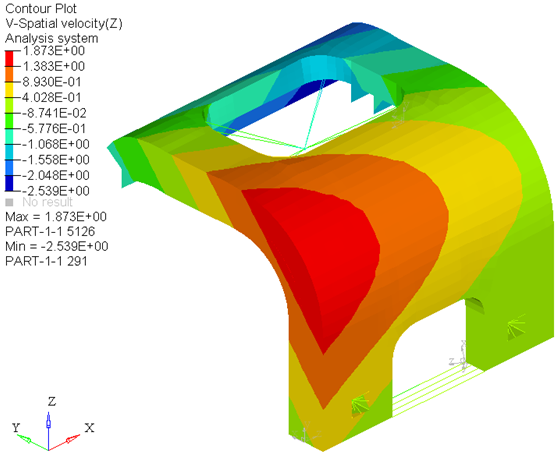
| 8. | Repeat steps 6 and 7, this time setting the Complex filter to imaginary to contour the imaginary component of the velocity. |
| 9. | Continue to repeat steps 6 and 7, setting the Complex filter to mag to contour the magnitude of the velocity and then phase to contour the phase of the velocity. |
| 10. | Set the Complex filter to mag*cos(wt-phase). This contours the response with varying angle or wt (in degrees). This filter will be used to animate the model. |
| 11. | Set the Resolved in system to Global System and click Apply. |
Step 3: Set the animation parameters and animate the model.
| 1. | Click on the Animation Controls button  . . |
This panel allows users to set the Current angle of the animation and also the Angular Increment of the animation.
| 2. | For Angular Increment, select 15. |
| 3. | Click on the Start/Pause Animation button  to start the animation. to start the animation. |
| 4. | Set the Max Frame Rate (on the left side of the panel) to 10. This will slow down the animation. |
Notice how the values for the Current angle are incremented by 15. This is because the Angular Increment was set to 15.
| 5. | Click on the Start/Pause Animation button  to stop/pause the animation. to stop/pause the animation. |
| 6. | Use the scroll bar for the Current angle to set the current angle to 0. |
Step 4: Create a measure of the nodal value at node 999 and plot the values.
| 1. | Click the Measure panel button  on the Annotation toolbar to enter the Measure panel. on the Annotation toolbar to enter the Measure panel. |
| 2. | Click on Add to create a new measure. |
| 3. | From the drop down menu, select Nodal Contour. |
| 4. | Click on the yellow Nodes input collector and pick By ID. |
The Select by ID dialog is displayed.
| 5. | Enter in the value 999 to select the node with the ID of 999. Click OK. |
This adds a measure at node 999. As displayed in the graphics area, the value at angle 0 is -2.474.
| 6. | On the right side of the panel, click on the Create Curves button. |
The Create Curves dialog is displayed.
| 7. | From the Place on drop-down menu, select New Plot. |
| 8. | From the Y-Axis drop-down menu, select Value. |
| 9. | Check the option for Live link. |
The Live link option creates a link between the selections made on the measure panel and the curve. When a live measure item is deleted, a message is displayed prompting you to either keep or delete the curve.
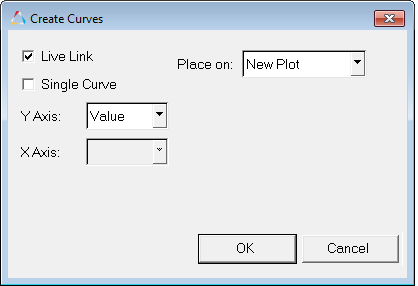
| 10. | Click OK. This creates a curve in the second window which has the phase angle in degrees on the x-axis and the measure value on the y-axis. |
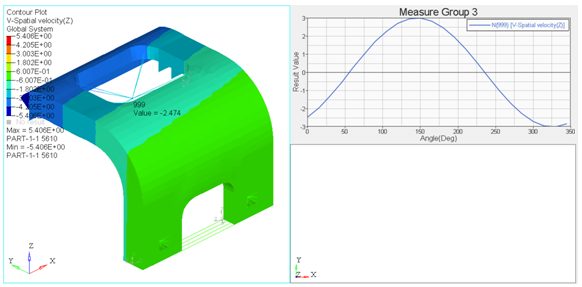
In HyperView, the formula used to create this plot is:
real*cos(wt)+imaginary*sin(wt)
Not all post processors use this equation though. Another possible equation used by other post processors is the following:
real*cos(wt)-imaginary*sin(wt)
Notice the slight difference in the equations. Next you will plot this second equation on the same plot as the measure curve to illustrate that the difference between the two is simply a phase shift.
| 11. | Click on the second window in the session to make it the active window. |
| 12. | Click the Define Curves panel button  on the Curves toolbar to enter the Define Curves panel. on the Curves toolbar to enter the Define Curves panel. |
| 13. | Click on Add to create a new curve. |
| 14. | For x=, select Math as the Source and then enter the following: |
0:360:15
This creates a vector which starts at 0, ends at 360, and is incremented by 15.
| 15. | For y= select Math as the Source and then enter the following: |
-2.474*cos(x*PI/180)-1.696*sin(x*PI/180)
In the equation above, -2.474 is the real value and 1.696 is the imaginary value.
Notice that the curves are identical except for the phase shift.
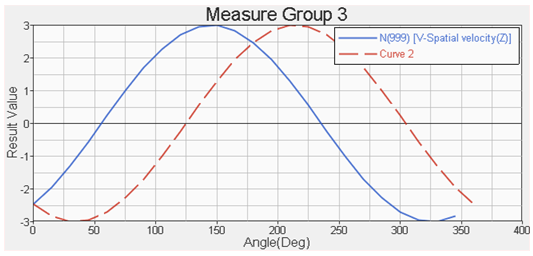
Step 5: Create a complex plot of the time history velocity values.
| 1. | Click on the third window to make it the active window. Change the window type to HyperGraph 2D. |
| 2. | Set the plot type to Complex (see below). |
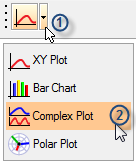
| 3. | Select the Build Plots icon  on the Curves toolbar. on the Curves toolbar. |
| 4. | For Data file, click the open file icon  and select the file Postprocessing_demo.odb. and select the file Postprocessing_demo.odb. |
| 5. | For X-Type, select Step-4 and Frequency. |
| 6. | For Y-Type, select V3-Spatial velocity (Time History); for Y-Request, select Node 999; and for Y-Component, select Value. |

This creates a complex plot with the Magnitude plotted on the bottom and the Phase plotted on the top.
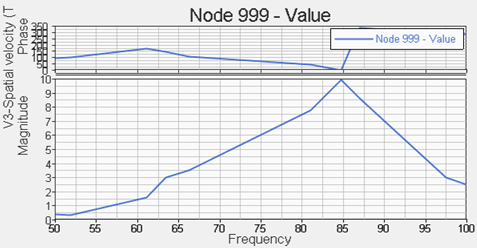
| 8. | Right click in the third window and select Switch to Real/Imaginary. |
This updates the plot so that the Real component is plotted on the top and the Imaginary portion is plotted on the bottom.
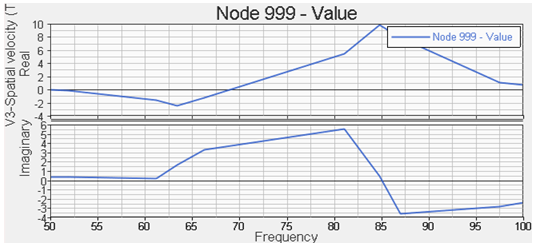
Step 6: Save the session (optional).
| 1. | Go to File > Save as > Session. |
| 2. | Enter in a name for the session file. |
| 3. | Click on Save to save this session file. |
This file can be opened later to retrieve the saved session.
See also
Contour Panel
Measure Panel
HyperView Tutorials for a complete list of HyperView tutorials
















![]() . After switching the animation mode to modal, an additional option appears in the Contour panel which allows the users to set the Complex filter.
. After switching the animation mode to modal, an additional option appears in the Contour panel which allows the users to set the Complex filter. 
![]() . Within the Animation Controls panel, use the Current angle entry field to enter in the value for the angle.
. Within the Animation Controls panel, use the Current angle entry field to enter in the value for the angle.
![]() .
. 









